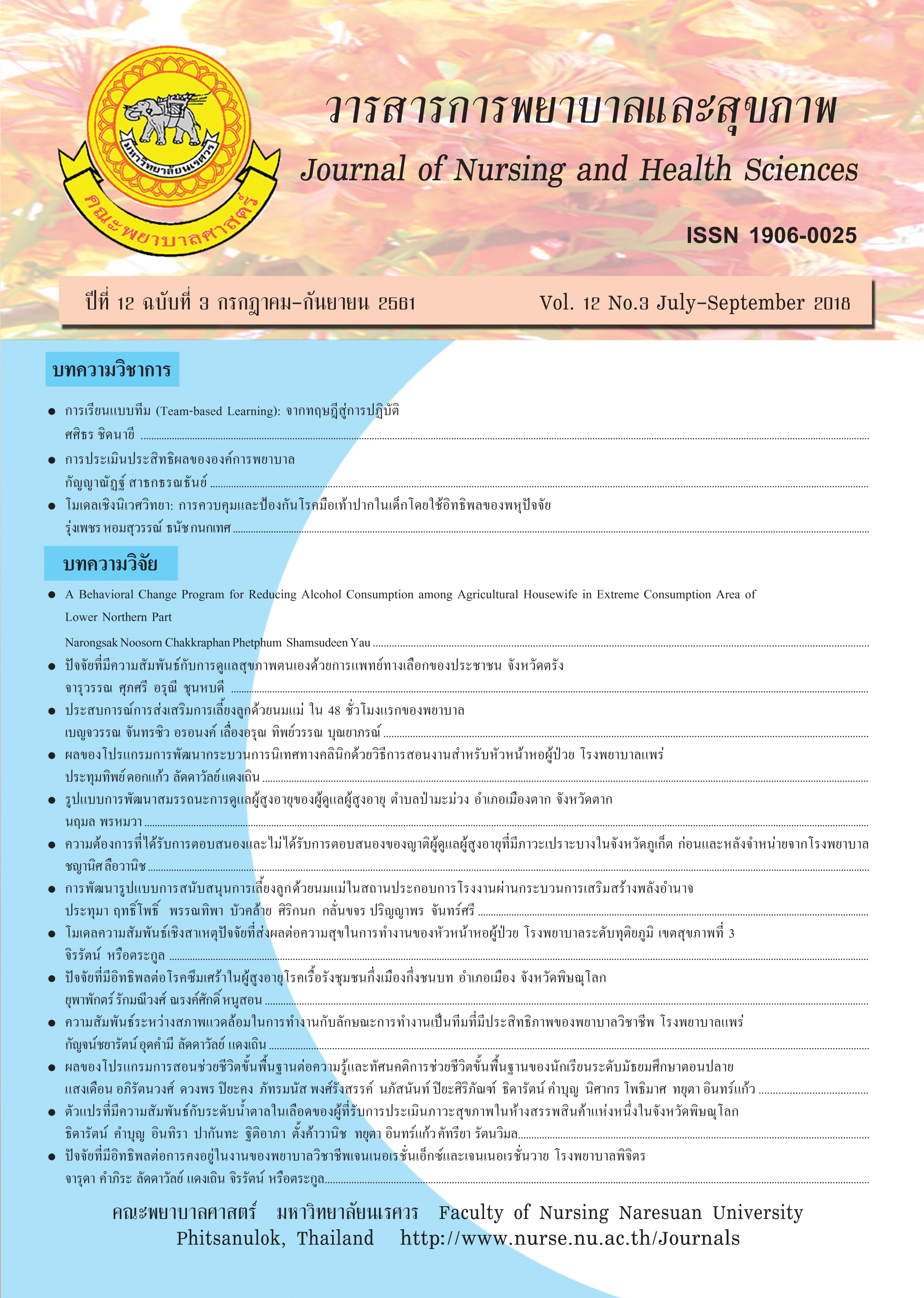The Causal Model of Factors Affecting Head Nurses' Happiness at Workplace in Secondary Hospital, Regional Health 3
Main Article Content
Abstract
The purposes of this research were to 1) develop the causal of factors affecting head nurses' happiness at workplace in secondary healthcare hospital region 3 and 2) validate the linear structural of causal model of factors with empirical data. In the present study, a causal relationship model was employed. The sample consisted of 104 head nurses by means of purposive sampling. The research variables consisted of 4 latent variables: perception of justice in the organization factors, awareness of the value of nursing profession factors,job satisfaction factors and factors of happiness at work. All latent variables were measured by 13 observable variables. The survey data were collected by using a five-point Likert scale questionnaire. The statistical analysis included descriptive statistics, frequency, percentage, mean, standard deviation, Pearson Product Moment correlation coefficient, and Liner structural model analysis was done by statistical package. The research findings were as follows: The causal factors affecting head nurses' happiness at workplace in secondary hospital region 3 were three factors. Ranking from high to low mean scores were: awareness of the value of nursing profession, job satisfaction, perception of justice in the organization.This three causal factors consisted of 13 observable variables. The causal model of factors affecting head nurses' happiness at workplace in secondary hospital region 3 was valid and fit to the empirical data. The model indicated that Chi-square (x2) = 20.15, df = 26, Comparative Fit Index (CFI) = 1.00, Root Mean Squares Error of Approximation (RMSEA) = 0.00, Tucker-Lewis Index (TLI) = 1.02 Standardized Root Mean Square Residual (SRMR) = 0.03. The job satisfaction factors in the model could explain the variance of head nurses' happiness at workplace being 37%. The happiness at workwas indirectly influenced by the factors perception of justice in the organization effecting through job satisfaction with the path coefficients of 0.42 and was indirectly influenced by the factors of awareness of the value of nursing profession effecting through job satisfaction with the path coefficients of 0.32. The happiness at work was directly influenced by the factors of job satisfaction with the path coefficients of 0.66.
Article Details
References
หมายและประสบการณ์ของพยาบาลวิชาชีพ.
(วิทยานิพนธ์พยาบาลศาสตรมหาบัณฑิต, สาขา
การบริหารการพยาบาล, บัณฑิตวิทยาลัย
จุฬาลงกรณ์ มหาวิทยาลัย).
จีราภา ปัญญากำพล. (2556). ปัจจัยที่ส่งผลต่อความสุข
ในการทำงานของพยาบาลวิชาชีพ โรงพยาบาล
เอกชน เขตภาคตะวันออก, 2(2), 104-108.
ธัชมน วรรณพิณ. (2555). ความสุขในการทำงานของ
พยาบาลวิชาชีพกลุ่มพนักงานมหาวิทยาลัย
โรงพยาบาลมหาวิทยาลัยภายใต้กำกับของรัฐ.
วารสารการพยาบาลรามาธิบดี, 18(1), 9-23.
ธานินทร์ ศิลป์จารุ. (2551). การวิจัยและการวิเคราะห์
ข้อมูลทางสถิติด้วย SPSS. กรุงเทพฯ: บิสซิเนส
อาร์แอนด์ดี.
เนตรสวรรค์ จินตนาวลี. (2553). ความสุขของการ
ปฏิบัติงานของพยาบาลวิชาชีพในโรงพยาบาล
จังหวัดสมุทรสาคร. (วิทยานิพนธ์ปริญญา
ศิลปศาสตรมหาบัณฑิต, มหาวิทยาลัยศิลปากร).
บุญใจ ศรีสถิตย์นรากูร. (2550). ระเบียบวิธีการวิจัยทาง
พยาบาลศาสตร์ (พิมพ์ครั้งที่4). กรุงเทพฯ:
ยูแอนด์ไอ อินเตอร์มีเดีย.
ประเวศ วะสี. (2542). วิสัยทัศน์ของกระบวนการเรียน
รู้ในหลักสูตรการศึกษาขั้นพื้นฐาน.วิชาการ,
2(1), 8-11.
ปวีณา ทองดี และคณะ. (2556). ความสัมพันธ์และปัจจัย
ทำนายประสิทธิผลของหอผู้ป่วยตามการรับรู้
ของพยาบาลวิชาชีพใน โรงพยาบาลแห่งหนึ่ง
ของรัฐในเขตกรุงเทพมหานคร. วารสารวิทยาลัย
พยาบาลบรมราชชนนี กรุงเทพ, 28(2), 1-2.
พวงรัตน์ บุญญานุรักษ์. (2545).กลยุทธ์ในการพัฒนา
ศักยภาพของพยาบาลวิชาชีพเพื่อการประกัน
คุณภาพ. วารสารคณะพยาบาลศาสตร์ มหาวิทยาลัย
บูรพา, 10(2), 32-48.
ฟาริดา อิบราฮิม. (2554).สาระทางการพยาบาลเพื่อ
ความรักและความภาคภูมิใจในวิชาชีพ.นนทบุรี:
ธนาเพรส.
ลดาวัลย์ รวมเมฆ. (2544). ผู้บริหารการพยาบาล:
บรรยากาศที่เป็นสุขในการทำงานบริการพยาบาล.
วารสารพยาบาลศาสตร์ จุฬาลงกรณ์มหาวิทยาลัย,
13 (1), 17-23.
วันชัย วัฒนศัพท์. (2557). คนไทยไม่ทอดทิ้งกัน: คู่มือ
การจัดการสร้างความปรองดองในระบบบริการ
สาธารณสุข. ขอนแก่น: ศิริภัณฑ์ ออฟเซ็ท.
ศิรินันท์ กิตติสุขสถิต และคณะ, (2555). คู่มือการวัด
ความสุขด้วยตนเอง. กรุงเทพฯ: โรงพิมพ์
ธรรมดาเพรส จำกัด.
สำนักนโยบายและยุทธศาสตร์ สำนักงานปลัดกระทรวง
สาธารณสุข. (2559). สถิติสาธารณสุข พ.ศ. 2559.
กรุงเทพฯ: สามเจริญพานิช(กรุงเทพฯ)จำกัด.
สิรินทร แซ่ฉั่ว. (2553). ความสุขในการทำงานของ
บุคลากรเชิงสร้างสรรค์: กรณีศึกษาอุตสาหกรรม
เชิงสร้างสรรค์กลุ่มสื่อและกลุ่มงานสร้างสรรค์
เพื่อการใช้งาน. วิทยานิพนธ์หลักสูตรวิทยาศาสตร
มหาบัณฑิต (การพัฒนาทรัพยากรมนุษยและ
องค์การ) คณะพัฒนาทรัพยากรมนุษย์สถาบัน
บัณฑิตพัฒนบริหารศาสตร์.
อิศรัฏฐ์ รินไธสง. (2555). การวิเคราะห์โมเดลสมการ
โครงสร้าง (Structural Equation Model): ทฤษฎี
แนวคิด การประยุกต์ใช้ในการวิจัยวิเคราะห์
ด้วย LISREL. สงขลา: สาขาวิชาการบริหารและ
การจัดการทางการศึกษา มหาวิทยาลัยทักษิณ.
Beugre, D. (1996). Analyzing the effect of perceive
fairness on organizational commitment
and workplace aggression. (Dissertation,
Rensselaer Polytechnic Institute).
Diener, E. (2008). Subjective Well-Being. Psychological
Bulletin, 95(3). pp. 542-575.
Edgar, L. (1999). " Nurse's motivation and its relationship
to the characteristics of nursing care
delivery system: A test of the job charac
teristics model." Journal of Nursing Leadership.
12(1). 14-22.
Greenberg, J. and R.A. Baron. (1997). Behavior
in organizational. 6th ed. New jersey:
Prentice-Hall.
Hair, J. F., Black, W. C., Babin, B. J., Alderson, R. E.,
& Tatham, R. L. (2010). Multivariate data
analysis. (7th ed.). Upper Saddle River,
New Jersey: Prentice Hall.
Jasmin, S., & Trygstad, L. (1979). Behavioral
concepts and the nursing process. St. Louis,
M.O: The C.V. Mosby.
Konovsky, M. A., & Cropanzano, R. (1991). Perceived
fairness of employee drug testing as predictor
of employee attitudes and job performance.
Journal of Applied Psychology, 76, 698-707.
Kumar, K., Bakhshi, A., & Rani, E. (2009). Linking
the big five personality on organizational
commitment of English teachers in Sri Lankan
government schools. International Journal of
Physical and social sciences, 3(1), 1-10.
Marsh, H.W.,& Hocevar, D. (1985). The factorial
invariance of student evaluations of college
teaching. American Educational Research
Journal. 21(2),341-366.
Organ, D.W., Podsakoff, P.M., & Mackenzie, S.B.
(2006). Organizational citizenship. behavior
its nature, antecedents, and consequences.
London: SAGE Publications.
Phillips, J. M. Douthitt E. A. & Hyland, H. M. (2001).
The role of justice in team member satisfaction
with the leader and attachment to the team.
Journal of Applied Psychology, 86(2),316-325.
Weiten, W. & Lloyd, A. M. (2003). Psychology
applied to modern life: Adjustment in the 21st
century. (7thed.) Belmont, Calif: Wadsworth/
Thomson.
West, S. G., Finch, J. F., & Curran, P. J. (1995).
Structural equation modeling: Concepts, issues,
and applications. Thousand Oaks, CA: Sage
Publications.


